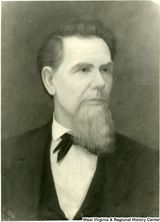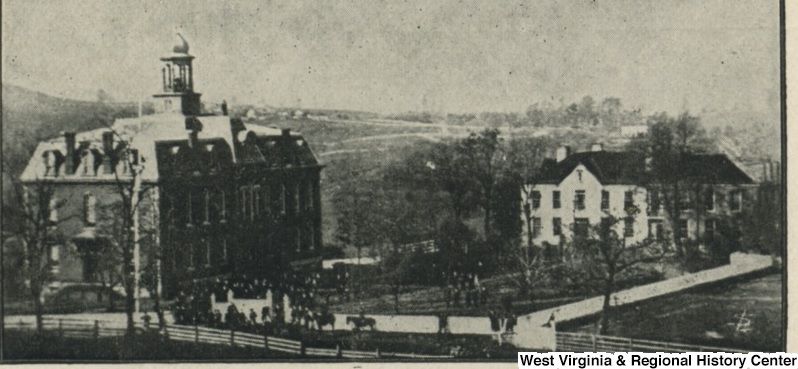Born of the Civil War, West Virginia was officially admitted to the United States
of America in 1863 as its 35th state. Until this time, the counties comprising
this region of the Appalachian Mountains were a part of the State of Virginia, one
of the original 13 colonies. When the State of Virginia voted to succeed from the
Union in 1861, inhabitants of the western counties refused to take this action.
Consequently, West Virginia is the only state in the union carved out of a confederate
state.
The Creation of West Virginia University
Once West Virginia became a state, it became eligible for funds to construct an institution of higher education provided by the Morrill Land-Grant College Act. According to the purposes of this federal legislation, institutions created using these funds were required to “teach such branches of learning as are related to agriculture and the mechanic arts…in order to promote the liberal and practical education of the industrial classes” (Section 4, Morrill Act, 1862). Morgantown, a town of 700 people located on a bend of the Monongahela River, was selected as the site for West Virginia’s land-grant institution. Combining funds with property donated from the existing Woodburn Female Seminary and the Monongalia Academy, the Agricultural College of West Virginia was formed on February 7, 1867, using a name appropriate for the land-grant act that largely funded it.
 Reverend Alexander Martin, pictured here, was named Professor of Mental and Moral
Sciences and selected as the college’s first president. That fall, the college admitted
its inaugural class of 6 students, who received instruction from its 6 faculty members,
a perfect 1:1 student-to-faculty ratio. Public high schools were not common in the
counties comprising the new State of West Virginia and no preparatory schools were
available, so limited numbers of young men were qualified for a higher education.
To remedy this situation, the college also sponsored a Preparatory School for young
men who aspired to attend college.
Reverend Alexander Martin, pictured here, was named Professor of Mental and Moral
Sciences and selected as the college’s first president. That fall, the college admitted
its inaugural class of 6 students, who received instruction from its 6 faculty members,
a perfect 1:1 student-to-faculty ratio. Public high schools were not common in the
counties comprising the new State of West Virginia and no preparatory schools were
available, so limited numbers of young men were qualified for a higher education.
To remedy this situation, the college also sponsored a Preparatory School for young
men who aspired to attend college.
It should be noted that President Martin envisioned the college as an institution that provided an education that extended far beyond agriculture and the mechanic arts. Adopting the President’s vision, the state legislature changed the name of the institution to West Virginia University in December of 1868. The curriculum included required courses that covered a broad range of areas of scholarship, including both “Mental Philosophy” and “Moral Philosophy,” courses taught by President Martin himself. Students paid $8.00 to cover tuition for college level classes and $5.00 to cover tuition for preparatory school classes.
President Martin was also responsible for the construction of University Hall, an academic building located on the grounds next to the Woodburn Seminary building (called Old Woodburn) that was used extensively during the early years of the institution. University Hall (currently named Martin Hall after the President who oversaw its construction) was completed in 1870.

University (Martin) Hall (left) adjacent to the Woodburn Seminary Building (right) in 1872.
The University’s space problems were only temporarily solved, as Old Woodburn burned down in January 1873, leading the legislature to erect a new building on the site of Old Woodburn, creatively named New Hall. New Hall opened in 1876, was renamed University Hall in 1878, and finally Woodburn Hall in 1902. Its north wing was added in 1900 and the south wing in 1911. Science Hall (now Chitwood Hall) was opened for use in 1893 to complete the historic Woodburn Circle at the center of the Morgantown campus.
As a young state born out of the Civil War, strong political tensions existed and the direction in which President Martin was taking the university was not shared by all in the state legislature. He resigned as WVU’s first president in 1875 and assumed the presidency of Asbury College in Indiana, forming it into what is now Depauw University.
The Creation of West Virginia University
Once West Virginia became a state, it became eligible for funds to construct an institution of higher education provided by the Morrill Land-Grant College Act. According to the purposes of this federal legislation, institutions created using these funds were required to “teach such branches of learning as are related to agriculture and the mechanic arts…in order to promote the liberal and practical education of the industrial classes” (Section 4, Morrill Act, 1862). Morgantown, a town of 700 people located on a bend of the Monongahela River, was selected as the site for West Virginia’s land-grant institution. Combining funds with property donated from the existing Woodburn Female Seminary and the Monongalia Academy, the Agricultural College of West Virginia was formed on February 7, 1867, using a name appropriate for the land-grant act that largely funded it.
It should be noted that President Martin envisioned the college as an institution that provided an education that extended far beyond agriculture and the mechanic arts. Adopting the President’s vision, the state legislature changed the name of the institution to West Virginia University in December of 1868. The curriculum included required courses that covered a broad range of areas of scholarship, including both “Mental Philosophy” and “Moral Philosophy,” courses taught by President Martin himself. Students paid $8.00 to cover tuition for college level classes and $5.00 to cover tuition for preparatory school classes.
President Martin was also responsible for the construction of University Hall, an academic building located on the grounds next to the Woodburn Seminary building (called Old Woodburn) that was used extensively during the early years of the institution. University Hall (currently named Martin Hall after the President who oversaw its construction) was completed in 1870.
University (Martin) Hall (left) adjacent to the Woodburn Seminary Building (right) in 1872.
The University’s space problems were only temporarily solved, as Old Woodburn burned down in January 1873, leading the legislature to erect a new building on the site of Old Woodburn, creatively named New Hall. New Hall opened in 1876, was renamed University Hall in 1878, and finally Woodburn Hall in 1902. Its north wing was added in 1900 and the south wing in 1911. Science Hall (now Chitwood Hall) was opened for use in 1893 to complete the historic Woodburn Circle at the center of the Morgantown campus.
As a young state born out of the Civil War, strong political tensions existed and the direction in which President Martin was taking the university was not shared by all in the state legislature. He resigned as WVU’s first president in 1875 and assumed the presidency of Asbury College in Indiana, forming it into what is now Depauw University.